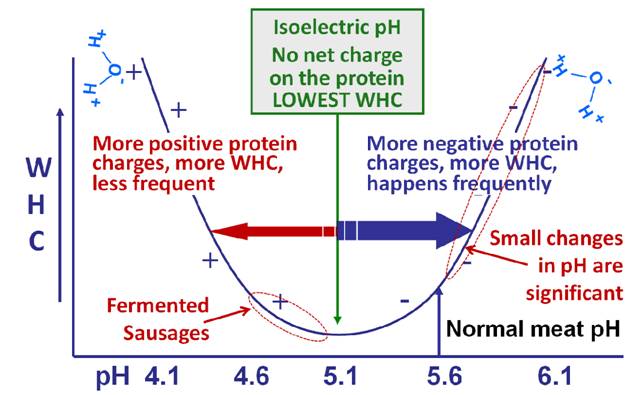Graphic Representation of WHC and Important Concepts
Because many of the factors affecting the dynamics of this chart may involve, among other things, animal genetics, ante-mortem handling, slaughter operations, and chilling efficiency, considerable diligence is required to develop a systematic approach to controlling WHC in finished products. However, the rewards can be excellent.

Figure III-2. Proteins, pH, and WHC - a graphic depiction of many of the essential concepts important to understanding WHC.
- For the effects shown by Fig. III-2 to be functional, the protein must NOT be denatured.
- Note the isoelectric pH at 5.1 where the WHC is the lowest possible.
- To the left with pH lower than 5.1, the net charge on the protein is positive which can bind water through the negative area on water. Seldom are meat products below the isoelectric pH.
- Note the oval near 4.6 to 5.0 where fermented or acid-marinated products would be. Since they are usually dried, their low WHC facilitates the drying process.
- On the right side of the isoelectric pH is where most fresh meat is. At a normal pH of ≈5.6, meat will have some WHC. Note that a relatively small increase in pH causes proportionately greater increases in WHC, thus less purge and greater yields.
- If the meat is PSE, the pH is usually closer to the isoelectric pH and it will have significantly more denatured protein, which results in lower WHC. The opposite holds for DFD meat which has a higher pH than normal. The greater negativity of the protein plus less protein denaturation gives DFD meat very good WHC.
- Special note: If the isoelectric pH of meat could be shifted downward, the meat at 5.6 would have greater WHC than normal. This is possible with the addition of some commonly used processing ingredients.